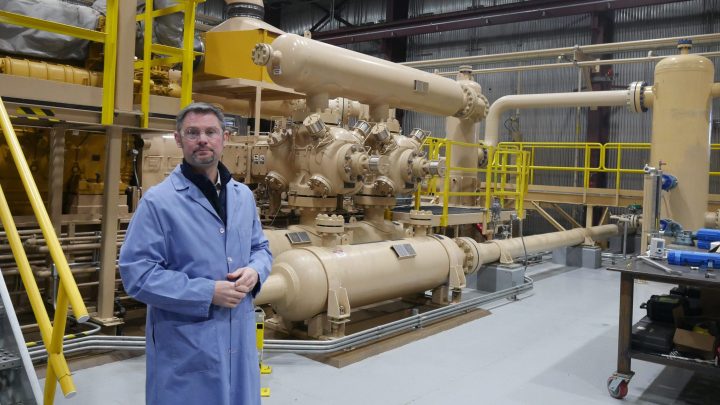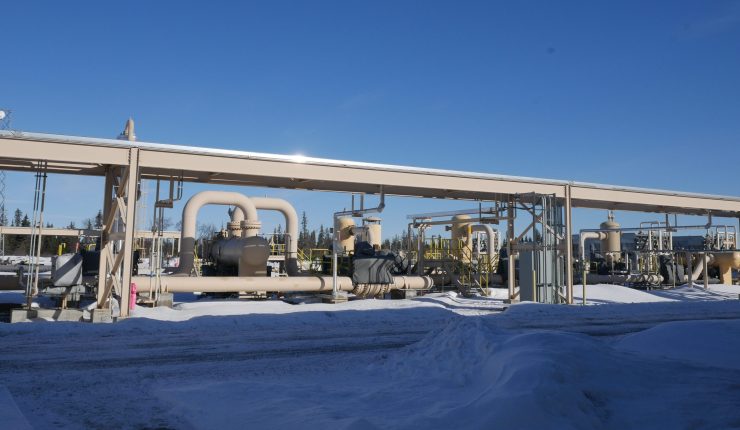
Alaska has “gobs and gobs” of natural gas, but still may need to import it
Alaska has “gobs and gobs” of natural gas, but still may need to import it

Three hours south of Anchorage sits a natural gas storage facility filled with pipes and whirring machinery. John Sims is the president of Enstar, the utility that provides gas powering 152,000 customers and electric utilities across a wide swath of the state.
“One hundred percent of our gas, since 1961, has come from Cook Inlet, which is right in our backyard,” said Sims.
Cook Inlet is a major gas production basin that is crucial to the state’s energy needs. And here at Cook Inlet Natural Gas Storage Alaska, or CINGSA, Enstar shoots gas into underground reservoirs for later — like when temperatures plunge to 20 below zero Fahrenheit and Alaskans turn up their furnaces and space heaters.
“This facility plays a massive part in making sure that the utility can meet those demands,” Sims said.
Demand for heating — and especially for electricity. About three-quarters of Alaska’s population depends on natural gas to keep the lights on. Sims said Cook Inlet used to have plenty of natural gas to power homes, businesses and industrial customers, with enough left over to export to Japan.
“It’s a critical piece. It’s one of the reasons why we’ve been able to have energy independence for 60+ years,” he said.
Alaska has long been known for its vast reserves of oil and gas. Those resources are the reason the state has its own sovereign wealth fund and cuts checks to its residents every year. And with the U.S. pumping more oil and gas now than ever, Alaska is the last place you might expect shortages.
But gas production in Cook Inlet has dropped dramatically. So much, Sims said, that a couple of years ago, the biggest producer started warning power companies that supplies are starting to dry up.
“Hearing that information and that news obviously was quite a shock to the utilities,” Sims said.
Shock might be an understatement. By 2027 or 2028, local natural gas production won’t cut it, according to industry estimates. So utilities immediately started looking for options, including at the remote North Slope.
“There are gobs and gobs and gobs of gas on the North Slope. Problem is, it’s almost 800 miles away,” said Larry Persily, a columnist and newspaper publisher who previously worked in the Barack Obama administration, and looked at building a North Slope gas pipeline.
“It’s across a couple mountain ranges, frozen tundra. It’s far away,” Persily said.
It just doesn’t make economic sense, he said. Alaska is famously big. Imagine a pipeline that runs from New York City to Jacksonville, Florida — that’s what you’d need to supply a market that makes up just about one-fifth of 1% of the U.S.’s total gas consumption. Even a pipeline the size of a garden hose would cost billions.
And that means the cheapest option is probably to import natural gas.

It’s kind of ironic: Alaska, the land of oil and gas, the state that pays its residents $1,000 or more every year just for living in a state with lots of energy, could be forced to import gas. It would just be embarrassing, Persily said.
“It’d be the equivalent of importing peaches into Georgia or importing avocados into Mexico,” he said.
Plus, gas imports are 30% to 60% more expensive. Still, that increase in cost — plus some supersized tax credits from the Inflation Reduction Act — are likely to lead to a transition toward renewable energy for Alaska’s grid, according to a new study from the National Renewable Energy Laboratory. Gas prices would have to fall significantly from current levels for renewables not to pencil out, according to study author Paul Denholm.
But that’s a ways off. It’ll take time for utilities to stand up new wind farms and solar panels. And while state lawmakers are considering a variety of ways to make gas-drilling cheaper or cut costs for consumers, John Sims with the gas utility Enstar said it could be a painful transition.
“There is no market-based solution that’s going to reduce the cost of energy to consumers,” he said. “That’s the unfortunate reality, and I think something the state of Alaska … needs to accept.”
In the meantime, while utilities deal with the coming natural gas shortage, he said Alaskans should brace for higher energy bills.
There’s a lot happening in the world. Through it all, Marketplace is here for you.
You rely on Marketplace to break down the world’s events and tell you how it affects you in a fact-based, approachable way. We rely on your financial support to keep making that possible.
Your donation today powers the independent journalism that you rely on. For just $5/month, you can help sustain Marketplace so we can keep reporting on the things that matter to you.

















